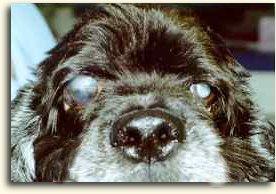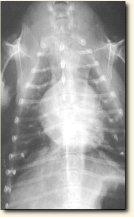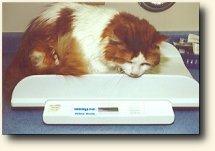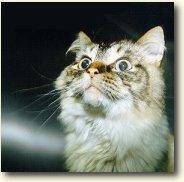Wednesday, July 06, 2005
The Older Pet Health Status Evaluation
The Older Pet Health Status Evaluation at ThePetCenter.com
The Older Pet Health Status Evaluation
 Introduction: Preventive medicine, whether for yourself or your family pet, has been a long established method of improving health. Essentially, it means early detection of those factors that may progress to disease. In addition, preventative medicine loosely defined may cross over into the realm of restorative medicine... that is discovering a malady in its early stages and correcting the disease process before it becomes a serious health risk.
Introduction: Preventive medicine, whether for yourself or your family pet, has been a long established method of improving health. Essentially, it means early detection of those factors that may progress to disease. In addition, preventative medicine loosely defined may cross over into the realm of restorative medicine... that is discovering a malady in its early stages and correcting the disease process before it becomes a serious health risk.Older dogs and cats have special problems easily overlooked even by conscientious owners. Dental and oral problems, kidney and bladder infections, diabetes, tumors and nearly any disorder common in humans is a possibility in our pet companions.
Goal: The ultimate objective of the "Older Pet Health Evaluation" is to assist patients in achieving a longer, healthier life. At many animal hospitals the veterinarians have developed an Older Pet Health Evaluation protocol that provides a very careful physical exam coordinated with a comprehensive laboratory analysis. The goal of this analysis is threefold:
1. To define areas of potential health risk.
2. To detect and correct existing health problems.
3. To encourage the pet owners to continue with health enhancing procedures.
PROCEDURE
Admission: The pet is admitted to the hospital in the morning and the veterinarian who is in charge of the case takes a thorough history (called anamnesis) and pays close attention to any major health impacting events in the pet's life. Current activity levels, nutritional factors and medications being administered are some of the topics discussed with the pet's caretaker. Vaccination status and recent health factors are also assessed.
Physical Exam: The veterinarian performs a thorough physical exam in the presence of the pet's caretaker, encouraging the pet's caretaker to make any comments that may prompt the veterinarian's information gathering so that any subtle or forgotten aspects of the pet's body condition can be evaluated. The weight is recorded (and should be recorded every time the pet is brought to the hospital) and any deviations from normal are noted on the health chart.
Routine Lab Checks: Blood is drawn for a basic Chemistry Panel and a CBC (Complete Blood Count) and a urine sample is collected. Usually the owner can obtain the urine at home in a clean container before the appointment. Take a look at common laboratory tests that are included in a Chemistry Panel and an example of a real urinalysis below.
 X-rays (Radiographs): If there is any indication of arthritis, abnormal aspects of the physical exam, or other suspicious elements in the history or physical exam, radiographs are taken to gather more data on the patient.
X-rays (Radiographs): If there is any indication of arthritis, abnormal aspects of the physical exam, or other suspicious elements in the history or physical exam, radiographs are taken to gather more data on the patient.Evaluation: When all laboratory test results are available, x-ray films have been read and the data gathering process is complete, the veterinarian will make an evaluation. If there are any substantial deviations from normal for a pet of this age, the veterinarian may suggest further tests be done. For example, if the patient is evaluated as being healthy but the history indicates a lack of energy or enthusiasm and the physical exam displays an overweight pet with some deficiencies in the coat condition... the veterinarian may suspect Hypothyroidism. Further blood testing with emphasis on the thyroid function will be suggested. Another example would be the suggestion of bone marrow biopsy if there seems to be a significant lack of platelets and white blood cells, or the biopsy of a lymph node if far too many lymphocytes are noted on the CBC (Complete Blood Count).
Action: The veterinarian will discuss the results of the entire "Older Pet Health Evaluation" with the pet caretaker and suggest actions that should be taken. If a biopsy or further blood or urine tests are indicated, permission is obtained from the owner to proceed with additional tests and the next steps are taken. If the pet is healthy, another "Older Pet Health Evaluation" is scheduled for the following year and the owner is encouraged to contact the veterinarian if anything suspicious develops in the interim.
SUMMARY
 The pet is admitted to the animal hospital for a preliminary discussion between the veterinarian and owner and a thorough physical exam is performed. Special attention is paid to dental health, presence of arthritis, abnormal growths, cardiac and ocular function, prostate and colon abnormalities and more. It is important for the owner to be present for the physical exam because the owner can provide important suggestions and answer pertinent questions at this time. The exam and medical history discussion may take somewhere between ten and thirty minutes and covers such topics as previous medical problems, dietary considerations, individual habits of the pet and how the pet relates to its environment. The patient is kept in the hospital for part of the day during which time blood and urine samples are procured for analysis.
The pet is admitted to the animal hospital for a preliminary discussion between the veterinarian and owner and a thorough physical exam is performed. Special attention is paid to dental health, presence of arthritis, abnormal growths, cardiac and ocular function, prostate and colon abnormalities and more. It is important for the owner to be present for the physical exam because the owner can provide important suggestions and answer pertinent questions at this time. The exam and medical history discussion may take somewhere between ten and thirty minutes and covers such topics as previous medical problems, dietary considerations, individual habits of the pet and how the pet relates to its environment. The patient is kept in the hospital for part of the day during which time blood and urine samples are procured for analysis.Some of the laboratory work is done "in house" at the animal hospital and some analyses are performed by local specialized medical labs that pick up specimens on a daily routine basis. The blood analysis includes what is commonly called a CBC and a CHEMISTRY PANEL. This is a very comprehensive hematological exam. The urine analysis checks for the presence of blood or bacteria in the urine and cultures can be done to grow any bacteria in order to determine the best antibiotic to use in therapy. Additionally, the urine density, protein level, acidity and other very important aspects of urinary tract health are evaluated.
 When the pet is discharged later in the day, the veterinarian will discuss the findings with the owner. The pet may need dental care, or have a growth removed before it gets unmanageable, or have an x-ray taken to evaluate a painful joint. At discharge from the hospital, the pet is scheduled for any follow-up work that the thorough physical exam revealed is needed. In addition, the owner receives a copy of the physical exam report and a copy of the laboratory analysis. Especially in the older dog or cat, periodic, thorough health evaluation is very important in maintaining an optimum "quality of life".
When the pet is discharged later in the day, the veterinarian will discuss the findings with the owner. The pet may need dental care, or have a growth removed before it gets unmanageable, or have an x-ray taken to evaluate a painful joint. At discharge from the hospital, the pet is scheduled for any follow-up work that the thorough physical exam revealed is needed. In addition, the owner receives a copy of the physical exam report and a copy of the laboratory analysis. Especially in the older dog or cat, periodic, thorough health evaluation is very important in maintaining an optimum "quality of life". *****************************************
The Urinalysis: The following tests are generally performed on a urine sample, and the urine from an interesting case is documented that display some abnormal results...
Specific Gravity... 1.005 This measures how concentrated or dilute the urine is so this is very dilute!
Protein... +1 (This is not very significant. +3 or +4 would be remarkable.)
Blood... Trace This is noteworthy but not alarming.
pH 5... This means that the urine is very acid. Urine almost never is this acid normally!
Bilirubin...None (This means the liver's internal bile channels are not obstructed.)
Ketones... None (This would be positive in diabetics and starving animals.)
Sediment (This displays any solids that are a part of the urine sample. The solids settle to the bottom of a test tube that is spun in a centrifuge. The fluid portion is poured off leaving the solids for microscopic exam.)
White Blood Cells: 50+ per HPF This means High Power Field: The microscope is getting a really close look! Fifty white blood cells per HPF is significant and indicates inflammation or infection and possibly leukemia.
RBCs: 5 per HPF This refers to Red Blood Cells and there should be none seen in a normal urine sample.
Bacteria: 2+ (0 to 4+ scale) Rods Rods are a type of bacteria and a normal urine sample should have no bacteria present.
Epi cells: 2+ (0 to 4+ scale) Epi (epithelial) cells are cells that line the inside of the urinary tract. 2+ epi cells may or may not be significant.
*****************************************
The Chemistry Panel: Some typical tests routinely included in a Chemistry Panel are displayed below. Each laboratory will provide the veterinarian a range of values that represent likely normal parameters. These "normal values" often will vary from lab to lab; there are good reasons to pick a reliable, professional laboratory that has a database of animal values against which abnormal values can be contrasted. Most veterinarians will suggest repeating a test if any values fall just out of the normal range because there may be transient abnormal values in a healthy pet, so if a value falls out of the "normal" range repeating the test in a few days will indicate if the suspect value truly is abnormal or if it has presently fallen back into the "normal" range.
Sodium
Glucose
Total Protein
Alkaline Phosphatase
Amylase
Potassium
BUN (Blood Urea Nitrogen)
Albumin
Alanine Amino- transferase (ALT)
Total Bilirubin
Calcium
Creatinine
Albumin/Globulin Ratio
Amylase
Total Cholesterol
*****************************************
The CBC: The Complete Blood Count is a highly important aspect of a complete "Older Pet Health Evaluation" because of the insight it provides into the invisible world of the individual's cellular environment. Even small deviations from normal should be followed by repeat tests to see if a pattern of higher or lower values are occurring. The usual parameters that are included in a CBC are the following:
White Blood Cell Count (WBC)
Mean Corpuscular Volume (MCV)
Red Blood Cell Count (RBC)
Mean Corpuscular Hemoglobin (MCH)
Packed Cell Volume (PCV or Hematocrit)
Mean Corpuscular Hemoglobin Concentration (MCHC)
Hemoglobin
Platelets
Segmented Neutrophils
Lymphocytes
Immature Neutrophils (Band cells)
Monocytes
Basophils
Myelocytes
Reticulocytes
Eosinophils
*****************************************
Most animal hospitals will suggest a Geriatric Workup for older pets as an important aspect of preventative veterinary medicine... "It is better to prevent disease than to have to cure it". The age at which a pet could be classified as a "Older Pet" is quite subjective. For example a Bull Mastiff may be considered geriatric at age 7 and at the same age a miniature poodle is just getting warmed up! Some cats live into their twenties and might be considered an "older pet beginning around twelve years of age. The effects of age on any individual are determined by a number of factors including environmental impacts, diet, activity levels, weight control and especially genetic predispositions. You, your pet and your veterinarian form a unit which, if all parts are in close integration with one another, can promote a lasting and rewarding "full life" experience for each individual. Consider asking your veterinarian about an "Older Pet Health Evaluation".
~~~~~~~~~~
Click on the link at the beginning of this article...
ThePetCenter.com
"The Internet Animal Hospital"
Comments:
<< Home
Unfortunately my doggies eyes look the same as this dog, but mine became blind because of retinal disease. Nothing could be done. He doesnt know he is blind though, he gets around great!
Post a Comment
<< Home
Please Note: That was NOT the last post in [The Blog] ...
Please review the ARCHIVE Section at the top on the left side.
| Home | Top | About | Authors | Archives | Affiliates | Newsletter | Links | Tag-Board | Site Feed | Utilities | News Feeds | The Cutest Pet! | Daily Cartoon | PetLvr Polls |
* Comments Welcome *

P E T L V R.com
EMAIL: info@PetLvr.com
TOLL-FREE FAX LINE: 1-(800)-613-2087
WINNIPEG, MANITOBA CANADA
JUMP TO THE PAPILLONLVR's DOG'S WEBSITE
PapillonLvr.com - pronounced: pap-e-yawn-love-er-dot-com


![PETLVR.com - [THE BLOG]](http://www.PetLvr.com/pics/logo_PetLvr_blog.jpg)
 1 comments
1 comments


![PetLvr.com - [The Blog] - Last 5](http://feeds.feedburner.com/centerpetlvrcom-theBlog/center.gif)




















